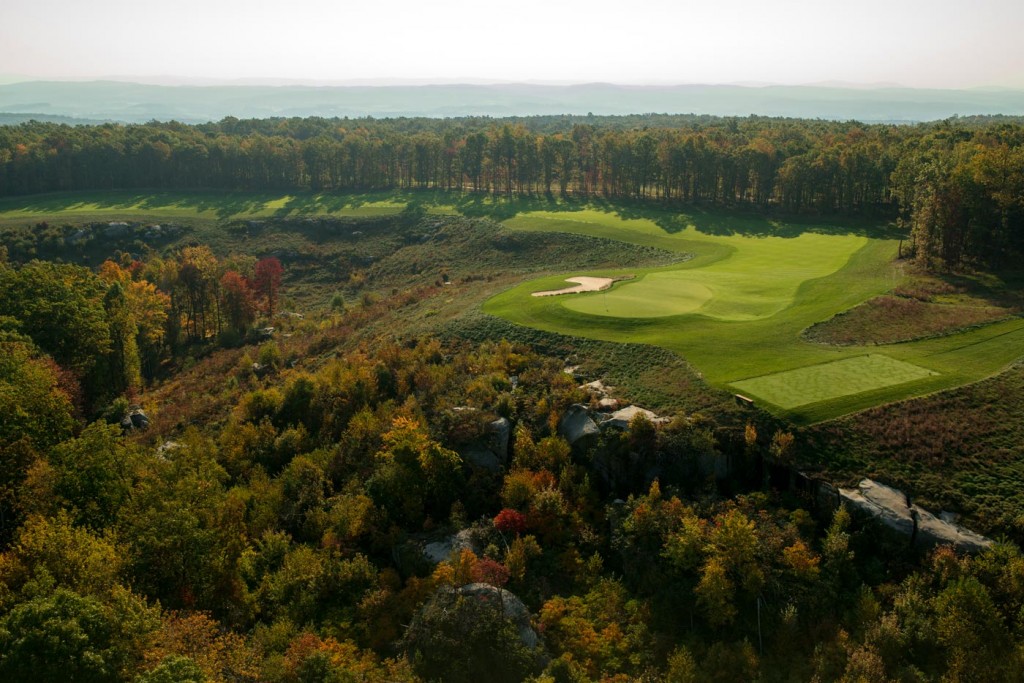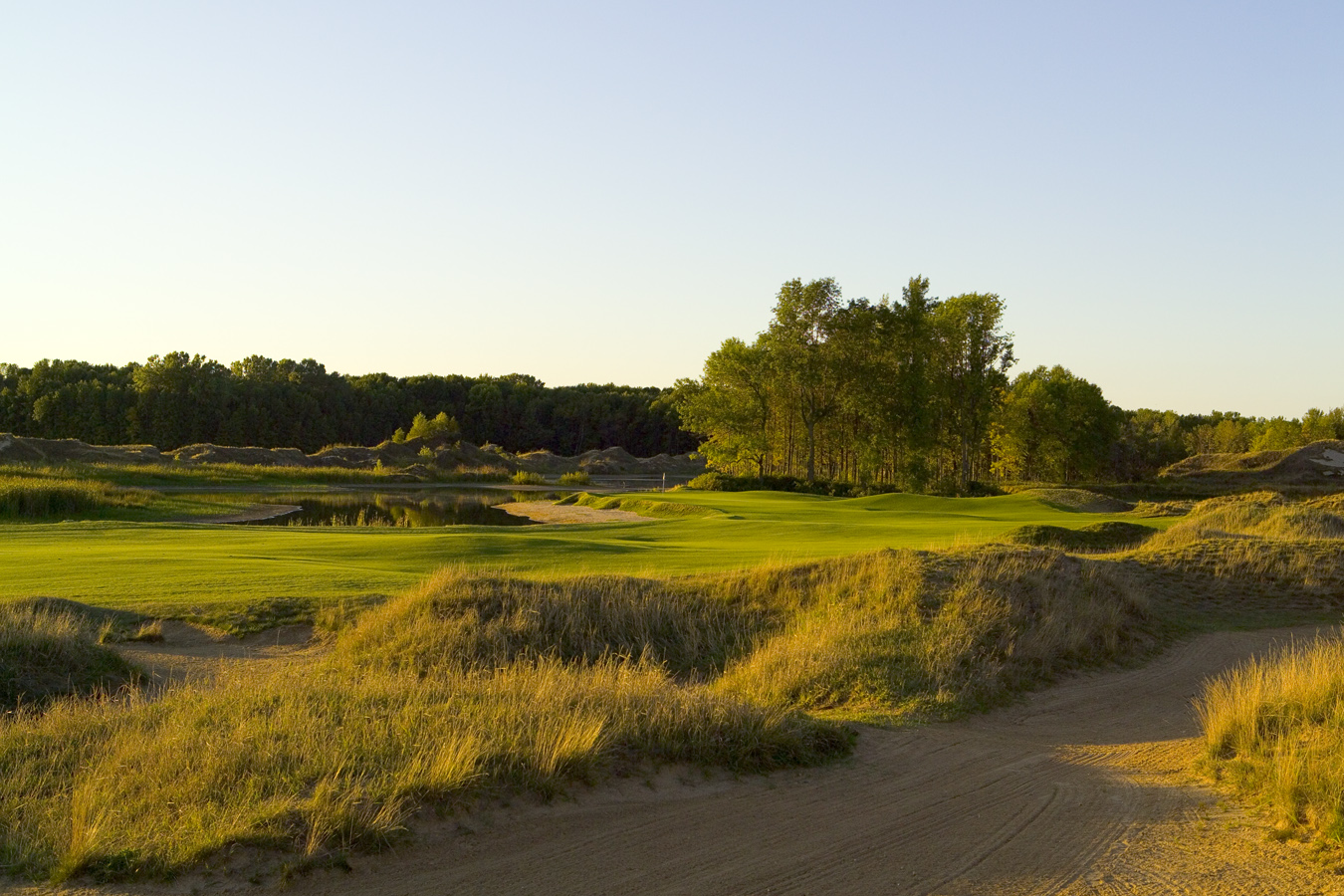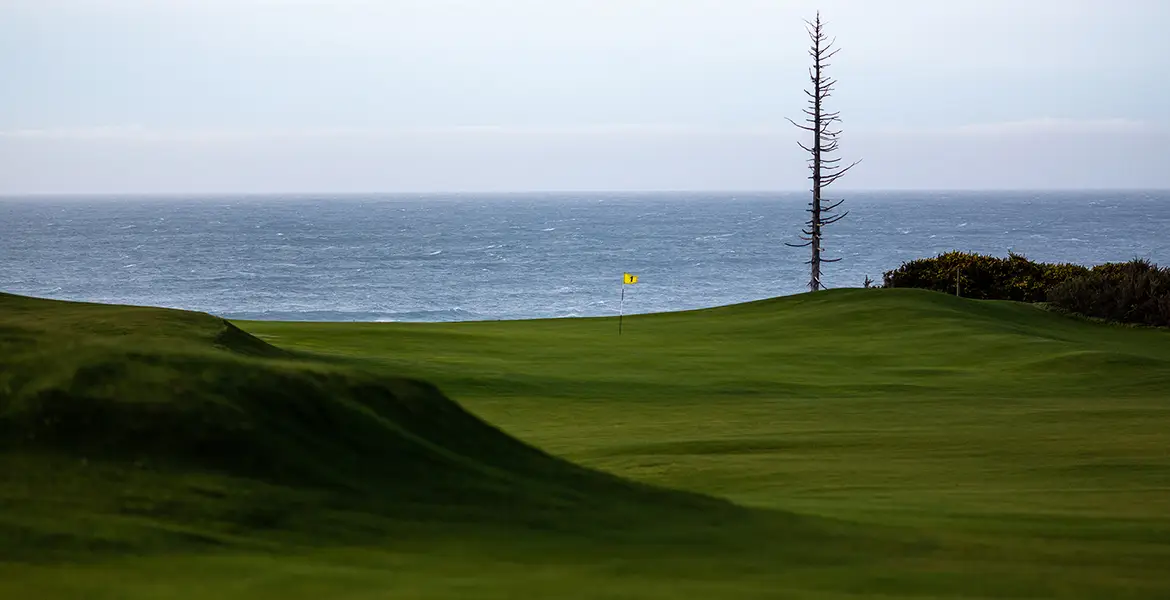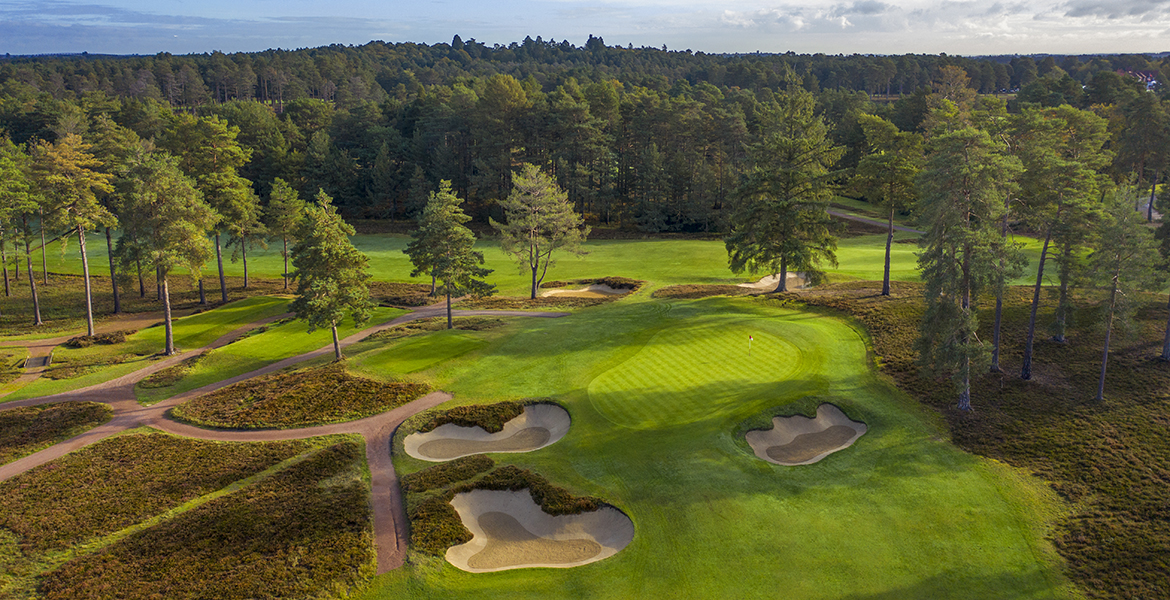You can’t help but take a few minutes to admire the views from the highest points at Pikewood National, which not only sits atop a mesa in the mountains near Morgantown, West Virginia, but has been continually climbing in national course rankings. The panoramic pit stops aren’t just because you’re treated to views of three states—Pennsylvania and Maryland as well as West Virginia—but also because you’ll probably need to take the occasional breather during your round.
Pikewood National is regarded as one of the most challenging courses in the U.S., with a 155 slope rating, a 79.3 USGA course rating and a brutal 109.4 bogey rating from its championship tees. It’s also one of the toughest walks in golf—a nine-mile hike up and down a mountain; and that’s if you’re hitting it straight. The course, which is spread over 650 acres and features elevation changes of hundreds of feet in just a few holes, is as taxing physically as it is on your scorecard.

But with all due respect to Mark Twain, Harry Leon Wilson, William Gladstone, or whoever it actually was who suggested golf is a good walk spoiled, Pikewood National is a phenomenal experience enhanced by the rigorous walk. It’s one you’ll appreciate every step of the way. And mind you, Pikewood is a cart-free property. It was also the course—as I traipsed up and down the side of the mountain—that got me thinking about the toughest walks in golf.
There are golf courses that would be a ridiculous challenge to walk, but aren’t designed for it. The Plantation Course at the Kapalua Resort on Maui is one that springs to mind—with extensive distances between holes as it climbs up and down an old volcano, it simply isn’t made for walkers. Also not considered for these purposes is a curiosity like Nullarbor Links, which bills itself as the world’s longest golf course, spanning multiple towns across 850 miles (1,365 kilometers) across Australia.
The four other U.S. courses listed here are considered walking-only or meant to be walked most of the time.
BETHPAGE BLACK
There’s a sign just behind the first tee at Bethpage State Park’s Black Course warning that the layout, a two-time U.S. Open host and site of the 2019 PGA Championship, is an extremely difficult course for highly skilled golfers only. There should probably also be a disclaimer on the sign about how challenging it is to walk the A.W. Tillinghast-designed course that takes on the rough-and-tough personality befitting its New York location. There are plenty of golfers who won’t play the Black because of its walking-only nature. Fairly substantial elevation changes are found on almost half of the holes, including a handful of memorable climbs. Among them is the approach to the green at the 15th hole, one of the hardest par-fours in the game. Several years ago, I was playing the Black with a good friend who, winded (and humbled) after the hike up the hill at No. 15 and over to the 16th tee box, plopped down on a bench and said simply, “Never again will I play this (bleeping) course.” He would, of course… because it’s a taxing yet utterly intoxicating stroll in the park.

CHAMBERS BAY
The first thing you’ll notice on the drive into Chambers Bay, which was built in an old sand and gravel mine on the Puget Sound outside Seattle, is the sheer size and scale of the layout and its topography. Course architect Robert Trent Jones Jr. has proudly boasted that the walking-only links-inspired layout is a 10-mile hike, with more than 600 feet of elevation change and significant distances between greens and the next tee. The views are spectacular—from the sparkling waterfront to the snow-capped Olympic Mountain range—and the steep climbs are equally impressive. When the U.S. Open was held at Chambers Bay in 2015, then USGA executive director Mike Davis described the course as an “endurance test,” and other tournament organizers said it would test both the physical and mental capabilities of competitors. If you go, bring comfortable shoes, and possibly a Sherpa.

WHISTLING STRAITS
Sculpted into two miles of uninterrupted shoreline of Lake Michigan in Kohler, Wisconsin, Whistling Straits can be an unforgiving brute. Designer Pete Dye isn’t known for his warm and fuzzy layouts, but if a golfer is errant on The Straits, which has roughly 1,000 sand bunkers, an already challenging walk can quickly become grueling. When looking at the bluffs and massive sand dunes, it’s hard to conceive that the site in the 1950s was flat farmland used by the U.S. Army as an anti-aircraft training facility. More than 7,000 truckloads of sand—approximately 105,000 cubic yards—were brought in to create the rugged, windswept terrain seen today that’s hosted three PGA Championships and the 2021 Ryder Cup. You may need to be as sure-footed as the Scottish Black Sheep that call Whistling Straits home.

ERIN HILLS
The first time the USGA’s Mike Davis saw Erin Hills in Wisconsin, the site of the 2017 U.S. Open, he said it looked like Shinnecock Hills on steroids. The brawny course is routed over the kettle moraine areas left by receding glaciers that formed the property’s rolling and undulating terrain. A walking-only course on 652 acres, Erin Hills is immense in scale. While you don’t have to play the tees that made it the second-longest U.S. Open course in history, you’ll still have many substantial walks past those other teeing grounds. The website for Erin Hills says to plan on a 4 hour, 55 minute round, and when the wind is blowing—and it often is—the walk can feel even more exhausting.

____________________
Can you think of any tougher walks than what we listed? Let us know in the comments below!







Streamsong courses in Florida.
I’ve walked all three courses and carried my bag. I’m not try to be contrary but these 3 are essentially flat courses by comparison to the ones on the list. I have always thought that Bethpage Black is THE HARDEST WALK in all of golf. I’m sure there are others but certainly they were never intended to be walking only.
The most brutal part of walk on Bethpage Black is the the 4 holes, Part of the reason is that by then you have walked 14 holes already , now it’s up that big hill to the 15th green, up to the 16th tee, up to the 17th green, up to the 18th tee, up to the 18th green, then finally, up from the 18th green to the parking lot(or inside for a cold one) Very tough walk but worth it!
It’s truly amazing what time does to change your thought pattern. Growing up on Long Island, Bethpage Black was our home course. I probably played it a couple of hundred times along with the Red and Green. Neither of them were a piece of cake to walk either. But we did and we carried our bags and never thought it was a problem. Different story today. Bring me a cart!
The Streamsong courses are terrific, and you get a nice healthy climb right out of the gate on Blue with that walk to the top of #1 tee box. A lot more elevation changes throughout than you’ll get on just about any other Florida courses, but not grueling walks certainly. That said, if you’re playing Streamsong during the heat of the summer, with nowhere to hide from the sun and the oppressive heat & humidity, those walks definitely get A LOT harder.
Spyglass Hill is a pretty tough walk
Agreed, really tough walk at Spyglass Hill, seems like every hole is uphill except for the par 3’s
Spyglass is no walk in the park!
Nicklaus said that you hit down on one and spend the next 17 holes walking back up.
Machrihanish Dunes! Also Fraserburgh. Carne is a stiff walk too.
Yes – did 36 on MC Dunes 18 with caddy and 18 carrying in 2010 at age 68.
Carne is a tough walk…especially in wind and rain but Bethpage in the summer ( Hempstead Plains) is well over 100* and humid!
Erin Hills
Whistling Straits
Chambers Bay
Bandon Dunes AND
Ocean Course on Kiawah Island.
The Ocean Course at Kiawah is completely walkable… they just shuttle you from 9 green to 10 tee…(it’s a lengthy walk).
In Austin, Barton Creek’s Canyons and Foothills’ courses will wear you out. Even when the round is finished at the Foothills course, you have a steep 40 yard walk to the clubhouse that seems to never end!
Try walking the Cashen course at Ballybunion in a 30mph wind. After already walking the Old Course in the morning.
Been there, done that, can’t wait to do it again.
I did exactly that — Walked Cashen in a 30 mph wind! Could barely bend my legs by the time I walked off 18! But beautiful scenery!
Done it twice and can’t wait to do it again. Other day comparable was European Club and Druid’s Glen which requires an 8 mile drive in between. Robert
Luck you. 1st group off Cashen in morning, constantly pushed by group behind us. Would have lost our way if not for my brothers exceptional caddie. (3hrs10) sorry we played so slow. Rushed to the Old Course immediately without break so the club could use our actual tee time for a group of VIP’s who were running late. 36 straight, walking and yes, the wind did come up in the afternoon. Tough walk that did not have to be.
It’s courses like these that are ruining golf for the average player, if for no other reason that they inspire imitations. Boo!
What about Cape Breton Highlands?
Highlands is a good walk, for sure.
Try Carnoustie on a cold, damp, windy day
Carnoustie is tough, but not for the walk, in any weather. It just beats you up – hole after hole.
Spyglass Hill is tough. Bandon Trails is definitely the toughest of the Bandon courses.
Bandon Trails and Spyglass are a couple others, for sure, that are at the top of my list in the U.S.
Whippoorwill CC in Armonk, NY, a six-mile walk up and down through the hills of Westchester County.
Agree, but really fun. Caddied there as a kid, got to play there last summer. Great memories
Royal County Down and Royal Portrush deserve honorable mention.
Didn’t think Erin Hills was a tough walk at all–mandatory caddies, walking without a bag on your shoulders anywhere is a snap!!
Want a tough walk–come play any of the courses in Tucson AZ at either Ventana Canyon or LaPaloma. These walks trump (no pun intended) any of the 5 you have listed.
I’m planning to play Ventana Canyon later this year; good timing! Sounds like a great choice…
Although the elevation changes might not be quite as intense as some, the Bandon Dunes property includes 4+ world class courses that all require walking … and pull carts are heavily discouraged as well. The combination of the sand base, significant tee to green distances, and not a bench in sight will test your endurance on any of the Bandon courses. It’s a good thing that there are wonderful views to enjoy while you rest.
I played all four Bandon Dunes courses several times each over a glorious week stay. I NEVER felt pull carts were “heavily discouraged as well.” Many, many players used [push] carts, myself included. Push carts were to be seen everywhere. That’s the only way a normal person could play 36 holes/day across multiple days.
The walk to the cash register at Pebble Beach.
Golf at The Bridge (NY) is a tough walk
For $40 try Mare Island (old Navy Base near Vallejo CA. $300 greens fee views for McDonald’s prices and the most challenging 5800 yard course you will ever play.
We walked Sand Valley two days in a row in July last year with temperatures hovering around 90 degrees. Drank a lot of water during the rounds and a lot of beer each night. The sun’s reflection off of the dunes seems to intensify the heat.
Bob, I’m getting my first look at Sand Valley (and Mammoth Dunes) in a couple months. Can’t wait for that and to see how great a walk those courses are. And the good news is that it definitely won’t be 90 degrees at that time…
Cliffs at Glassy in Greenville, SC ranks high on my list.
https://cliffsliving.com/glassy-golf
Kingsbarns in Scotland 36 holes back to back rounds walking carrying my own bag was a challenge but a magnificent Golf Course!! 16-18 miles !!!
Love it… Talk about a memorable experience!
concur..
Kingsbarns was the one course that came to mind for me. I registered 10 miles on my watch during our round there last October. Up and down and all around, but one of the finest courses I have ever played.
Mayacamas in Santa Rosa, CA… The back nine elevation changes will exhaust you! Beautiful and challenging course!!
I’ll have to add this one to the list of must-plays! Another California course that’s among my toughest walks (although not walking specific) is the Nicklaus Club in Monterey. I walked it late in the day with some friends while covering the US Open one year, when it was still Pasadera, and some of the climbs still stick with me to this day as we raced to beat the darkness.
Mayacama for sure. Essentially a walking only course with very steep hills throughout. And try walking the lanai course at Manele – although the walk always gets easier if you’re enjoying panoramic ocean views in the perfect weather of Hawaii
Cruden Bay is a wonderful, exhaustive walk. The hike up to the 9th hole is tough but the view more than makes up for it.
Agree on Cruden Bay…the steep hike from 8 green to 9 tee is breathtaking…literally! Marvelous course!
Walked it last summer. Well worth the hike!
Amen to Whistling Straits. Didn’t seem like we ever walked on level terrain other than a tee box. At age 70 and after three back surgeries, two knee surgeries and a torn Achilles, I find myself avoiding the new “walking only” layouts despite a desire to play them and having the time and financial resources to do so. And I’m not alone.
Not in the same league as these, perhaps, but I found the Charleston National Course (7064 yds, 142 slope, 74.7 rating) to be not only a tough golf challenge, but also one of the longest to, due to the layout. Although it’s generally flat, the distance between tees is considrable and the cutbacks and turns make it a true challenge for the golfers who choose to walk.
Allegheny CC with two bags as a caddy in the 60’s; up and down hills in Western PA. The members has a tow rope to get from the third green up to the fourth tee. Never got to play the course using the regular tees 🙁
On England’s Norfolk coast, Cromer and Sheringham’s tees and greens are never at the same elevation. Even walking down the hills can be a test. Rountree’s drawings illustrate them in Darwin’s Golf Courses of the British Isles (pg. 98 and 100).
Any one of a dozen courses in Northern Michigan are tougher than Erin Hills (which I’ve played twice).
I had a chance to play a series of Northern Michigan courses this past year for the first time. Some really spectacular ones, and some terrific walks — Crystal Downs, Kingsley, The Loop…. But most of the others we played (Boyne, Grand Traverse, Bay Harbor) we were given carts, so they weren’t walking only. Which one in particular stands out to you as the toughest walk there in N Mich?
John didn’t reply (yet?), but see my comment further down re. N. MI courses. You can walk any of the Forest Dunes courses (mandatory at The Loop) – not tough walks though. The only course I think they let you walk at Boyne is The Moors (not tough at all). Lots of nice courses in N. MI – I think you may be able to get some of them to let you walk in off season/on weekday (like Treetops let me).
Ko’olau outside Honolulu. Walked 36 there one day. Terrain isn’t so imposing as the difficulty. 162 slope when I played it about 10 years ago….
Walked Whistling Straits with a partner (6) in 3.5 hrs at age 65! Pulled out my scorecard at #12 & had to carefully separate it!
Walked Aronimink in August in a foursome at age 68 & tipped my caddy $100 for helping up #18!
Would do it again at age 75!
Love it! Even the image of the scorecard, haha… I think we’ve all been there before on hot or wet days.
Interestingly, I have walked most of these courses (including the ones in the comments) with the exceptions of Pikewood National and Spyglass. Enniscrone in Ireland was an 11 mile walk (measured by two fellow golfers) up and down and in and out of sand dunes. First day, I carried; the next day I took a push cart.
I have played almost all of the noted Irish courses in my 25 visits there. I would not list County Down as an extremely tough walk, but a great experience. The toughest walk for me was the Cashen course at Ballybunion. Walked and carried on morning when I could not get a slot on the Old Course.
Followed with a caddie in late afternoon on the Old Course — a great day!
Castle Stuart in Scotland should be mentioned as even the pros get a cart ride up one hill from green to tee. Many of the great British Isles courses test your stamina, but walking is the ONLY way golf should be played there and in the USA!
Totally agree on Chambers Bay, and that’s before you throw in the wind and rain. If it’s your lucky day there will be a shuttle for the longest uphill trek.
Wolf Creek. I didn’t walk it, but looked way more difficult to walk than Bethpage Black which I carried 2 bags as a caddie for years
Haha! Yes, there’s a reason you and I both took carts when we played Wolf Creek — they won’t even let people walk! Riding only… Incredible place. And one of my lasting memories is driving up a ridge and hearing, from a cliff on the other side of a canyon, the squealing brakes of a cart trying to precariously work its way down one of those treacherous descents…
Agree with most of the comments. Here are a few others especially if you’re carrying: Yale University Golf Course; Crystal Downs; Prairie Dunes; Pennard; Highland Links in Nova Scotia;
Crystal Downs!?!! Hope you appreciate how fortunate you are to have been able to play there. And walk it no less!
ERIN HILLS hands down! It’s the “holes between the holes” that kill you!
Having walked both the Black and Whistling Straits, Erin Hills is the killer!
For a course built essentially on a giant rectangle of land with few trees, environmental hazards or water, Newport National in RI is a REALLY long slog, especially into a strong wind. The layout forces a lot of seemingly unnecessary walks from green to the next tee. I almost quit the game walking up the par five 14th into a strong headwind.
Erin Hills was tough. I walked 36 holes in one day with a caddie and man I felt it afterwards. The extra punish at Erin Hills is that when you finally finish 18, you still have to walk what seems like a mile back to the clubhouse, and then up a hill to the parking lot.
I don’t think any of the Bandon courses are hard to walk. I play 5 days straight and walk 36 holes per day almost every year. I feel like I got run over by a truck when I’m done with the trip, but that’s due to 5 days of golf and much less about walking any one course.
Lahinch wore me out. Cruden Bay is no walk in the park either!
Bought the day ticket at Cruden Bay – played 3 rounds in 7.5 hours. Wasn’t tired (even at age 58). Such a spectacular course, the incredible golf is enough to give you all the stamina you need for the beautiful walk.
Nobody said Augusta…
Castle Pines at 6,400 feet
Agree on all, particularly Ballybunion, Bandon Trails, Carnoustie, Cruden Bay, Doonbeg, European Club, Ko’olau, LaHinch and Spyglass, but would add Royal Aberdeen on the North Sea and Spanish Bay on the Pacific when winds are howling and the birds take cover. Sadly, a damaged lung precludes acceptance of recent invitations to Erin Hills and Whistling Straits. For the rest of you, keep on walking as long as you can!
Bellmullet in Ireland… Nothing compares…
Toughest courses in Michigan I’ve walked 18 holes:
* Lochenheath (outside of Traverse City) (Williamsburg)
* Jones Masterpiece at Treetops (Gaylord) — this is a carts-only course, but I talked them into letting me walk (carrying my bag) a late fall round. Only need 3h 15m but there are some nasty hills that got my heartrate up there. It was awesome.
Agree, the original Treetops course would be a tough walk.
How about Threetops?
Lots of elevation changes there too, but being a 9 holer, so short (par 3 after all), and short distances between green/tees, I would imagine it to be no problem (carts req’d is the trouble).
Oh, one more:
* Black Forest at Wilderness Valley (Gaylord). It’s a mile walk from 18 green back to the parking lot. Thanks Tom Doak, I’ve been able to walk all his MI courses.
Rainmakers in Alto, NM is definitely a challenge that few people have done.
Ballyneal in Colorado is a challenge but worth the effort.
Cashen after the Old at Ballybunion was the hardest by far, the best, Lahinch in a blowing mist, heavenly….
Carried all 27 at Carne on the first day of Ireland trip. Folowed by nine straight days of carrying in the northwest and Northern Ireland.
Would not have been possible without the fortification of the “Black Stuff” ( Guinness). I’m 70 and hope to do the Irish courses as many more times as possible.
Agree with others that the Cashen course can be difficult, especially in rain and high winds.
The Castle Course in St.Andrews, Capilano Cc in Vancouver,B.C., The Ranch GC in SanJose,Ca., Tot Hill Farm in Asheboro,N.C., Wolf Creek in Mesquite, Nv. & The Highlands Course at Primland Resort in Meadows of the Dam, Va. will suggest you carry a VERY light bag!!